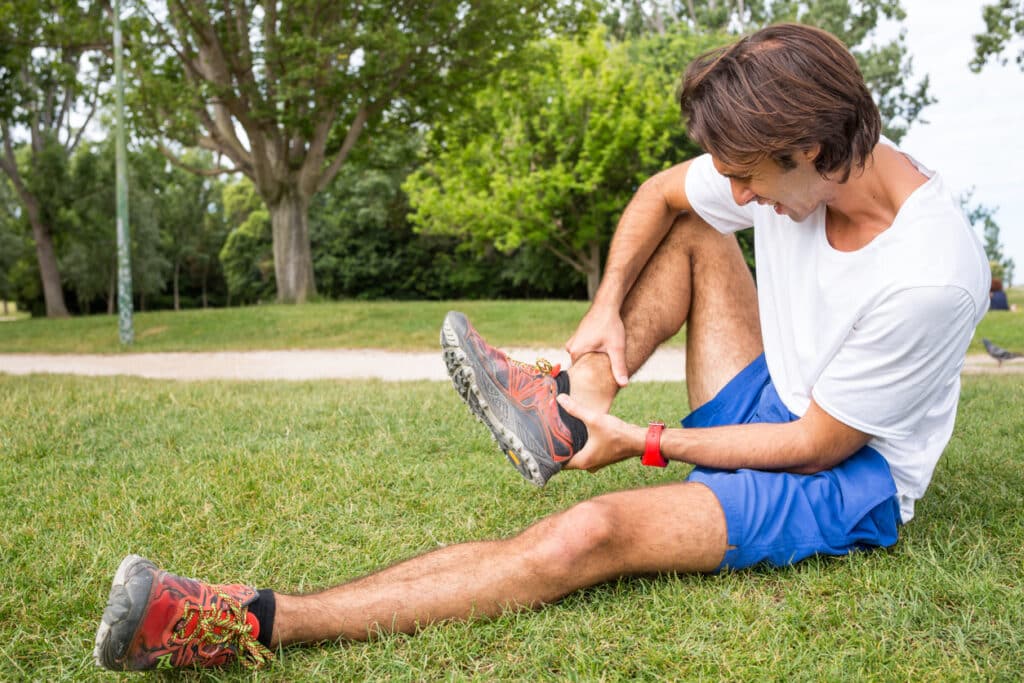
Lateral ankle sprain is a common injury, especially among athletes, that could cause pain and discomfort for days, and if not properly treated, it may progress into a recurring issue that causes weakness, stiffness, and instability.
One of the essential elements of treating this condition is rest; however, patients are sometimes apprehensive about resting their injured limb, worried that the pain might get worse or become unbearable. If you are one of these people, then you have come to the right place. In this blog, we will answer the question, “Does lateral ankle sprain hurt when resting?” We will also look at how physiotherapy and chiropractic care could help you recover from this injury. Understanding how your ankle responds during periods of rest can help you manage pain better and recover faster. Lateral ankle sprain occurs when the ligaments of the ankle joint stretch or tear beyond their limits, causing pain and swelling. Almost every patient with this injury is advised to rest their injured ankle for a few days to allow the injury to heal. During the resting period, the ankle should be elevated, and patients should avoid putting weight on it. This rest period may cause some discomfort, but it is essential to give the affected tissues time to heal and reduce the risk of reinjury. The degree of discomfort often depends on where you are in the stages of a lateral ankle sprain, since early inflammation tends to cause sharper pain and swelling, while later phases can bring stiffness or lingering soreness as the tissues rebuild and strengthen.
However, patients sometimes worry that the pain will become unbearable, and they cannot rest their ankle since the pain seems to increase when the limb is not moving. This could be due to inflammation and the buildup of fluids around the injured area. Elevating the ankle above the heart level and applying cold compresses at regular intervals can help reduce the swelling and discomfort, making the rest period more manageable. In some cases, discomfort during rest happens because circulation slows down when the joint is still. Gentle ankle mobility exercises or toe movements (when approved by a physiotherapist) can help ease this tension without straining the injury. Some people also notice that discomfort from a lateral ankle sprain that worsens at night can feel more pronounced when inflammation peaks and movement decreases, which is a normal part of the recovery process and typically improves as healing progresses.
Physiotherapy is a crucial treatment option for lateral ankle sprain, and it can help patients recover more quickly while minimizing the risk of developing chronic conditions. Physiotherapists use a variety of techniques, including exercises, massage, and electrotherapy, to improve range of motion, reduce inflammation, and improve circulation to the injured area. They can also help identify any muscle weakness or imbalances that contribute to the injury and provide tailored exercises to address those issues. At CARESPACE, physiotherapists also focus on gradual weight-bearing progressions, balance training, and proprioception exercises. Incorporating the best exercises for a lateral ankle sprain into your rehabilitation plan helps restore strength, improve flexibility, and reduce the risk of future injuries.
Chiropractic care is another alternative therapy that could help manage pain and restore full ankle function. Chiropractors focus on the relationship between the spine and the nervous system, and they use spinal adjustments to improve the body’s overall function and stimulate the body’s natural healing ability. Chiropractic care for lateral ankle sprain could involve adjustments of the ankle joint to improve mobility, reduce pain and swelling, and prevent scar tissue build-up. Chiropractors at CARESPACE often complement physiotherapy by restoring normal joint motion, which helps ensure smoother movement and more balanced recovery.
In conclusion, lateral ankle sprains can be painful, and patients may worry about resting the affected limb. However, rest is a crucial aspect of the recovery process, and patients must follow their healthcare provider’s advice to avoid further injury. Patients may also benefit from physiotherapy and chiropractic care to boost their recovery while reducing the risk of complications such as chronic instability. Combining proper rest with professional guidance can make healing faster, safer, and more effective. “Active rest”—staying lightly mobile while protecting the joint—helps reduce stiffness and supports long-term ankle health. If you are experiencing lateral ankle sprain, speak to your healthcare provider today to get personalized treatment options and get back on your feet as soon as possible.
If you have any questions or would like to explore further, please book a free, no-charge online appointment with either myself, Dr. Tyler Baron, BASc, DC or another Kitchener chiropractor at CARESPACE. We are happy to listen and are here to help!
To better understand how quick directional changes and uneven surfaces contribute to ligament injury, visit our Lateral Ankle Sprain page.

